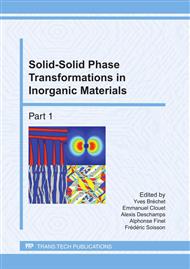p.608
p.618
p.624
p.633
p.640
p.646
p.652
p.658
p.664
Kinetic of Formation of Ni and Pd Silicides: Determination of Interfacial Mobility and Interdiffusion Coefficient by In Situ Techniques
Abstract:
The formation of metal (Ni and Pd) silicide thin films on a Si wafer is analyzed using differential scanning calorimetry (DSC) and isothermal X ray diffraction measurements. The sensitivity of DSC is remarkable even in this experimental Ni/Si and Pd/Si(001) and allows to show two steps of growth for a phase formation (lateral and normal growth). This technique is shown being of main interest for characterization of silicide formation during microelectronic industrial processes. Combining X-ray diffraction measurements and DSC measurements, the interface mobilities and the effective diffusion coefficient characterizing Ni2Si and Pd2Si growth are measured. These quantities as well as the interface mobilility for lateral growth have been determined by using a model taken into account the nucleation and lateral growth as well as a normal growth controlled by diffusion and interface reaction.
Info:
Periodical:
Pages:
640-645
Citation:
Online since:
June 2011
Authors:
Price:
Сopyright:
© 2011 Trans Tech Publications Ltd. All Rights Reserved
Share:
Citation:


